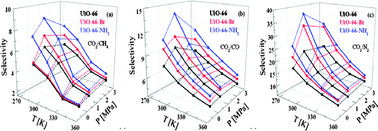In this work, the cooperative effect of temperature and linker functionality on CO2 capture in metal–organic frameworks (MOFs) was investigated using experimental measurements in combination with molecular simulations. To do this, four MOFs with identical topology but different functional groups on the linkers and three important CO2-containing industrial gas mixtures were adopted. The interplay between linker functionality and temperature was analyzed in terms of CO2 storage capacity, adsorption selectivity, working capacity of CO2 in temperature swing adsorption (TSA) processes, as well as sorbent selection parameter (Sssp). The results show that the effect of linker functionality on CO2 capture performance in the MOFs is strongly interconnected with temperature: up to moderate pressures, the lower the temperature, the larger the effect of the functional groups. Furthermore, the modification of a MOF by introducing more complex functional groups can not only improve the affinity of framework for CO2, but also reduce the free volume, and thus may contribute negatively to CO2 capture capability when the packing effect is obvious. Therefore, when we design a new MOF for a certain CO2 capture process operated at a certain temperature, the MOF should be designed to have maximized affinity for CO2 but with a negligible or small effect caused by the reduction of free volume at that temperature and the corresponding operating pressure.

You have access to this article
 Please wait while we load your content...
Something went wrong. Try again?
Please wait while we load your content...
Something went wrong. Try again?


 Please wait while we load your content...
Please wait while we load your content...